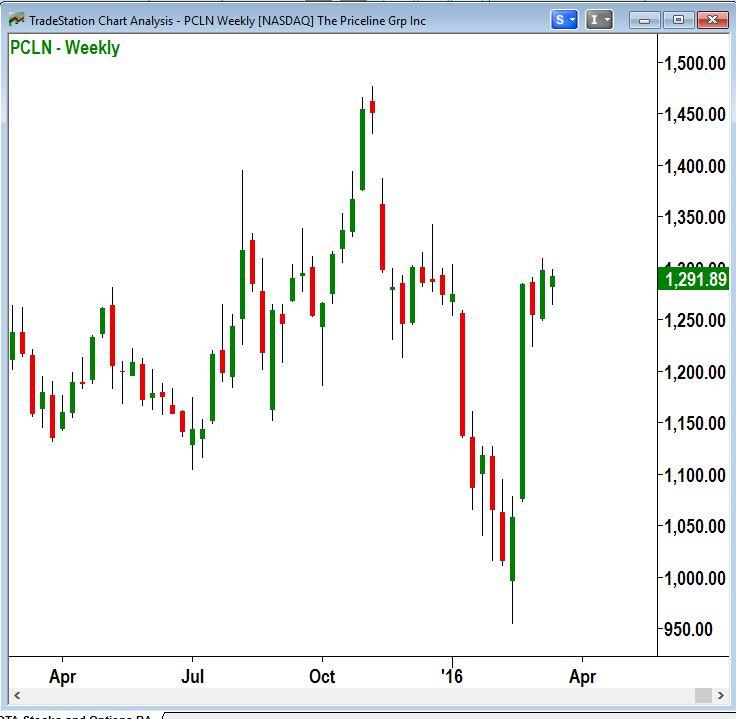Last week I described a way to use options as a way to trade high-priced stocks, like Google or Priceline, with much less cost and risk than trading the stocks themselves. Below is the chart of Priceline as of our starting point on March 9, 2016.
I compared two alternative trades to implement a bearish outlook:
Sell the stock short at the price at the time around $1292, with a target around $1100 and a stop-loss price at around $1310.
Buying a July put option at the $1300 strike, with orders in place to close out the trade if PCLN hit either our $1310 stop or $1100 target.
That article calculated that of the two trades, the put purchase had a potential to make 62% of the profit that the short stock sale would make if the stock reached the $1100 target; while tying up only 15% as much cash, for a much better cash-on-cash return. Today let’s look at using an additional option to improve the risk-reward possibilities even further.
At the time that we could have bought the $1300 put described before for $90.70 per share, we could have simultaneously sold a put near our $1100 target and received about $20.00 per share. Changing this trade from a simple long option into a vertical spread would do several things:
It would reduce the net cash out of pocket required to enter the trade, from $90.70 to $70.70 per share, since we would be collecting $20 per share for the short 1100-strike put.
If PCLN rallied to the $1310 stop-loss point, the loss would be less by about two dollars per share – about $14 per share instead of about $16 per share with the long put alone. This is because the short put would lose value in that case (good for us), and this would partially offset the loss in value of our long $1300-strike put.
If PCLN did drop down to the $1100 target, the profit on the trade would be about the same with or without the short put, if the decline took a long time. If it took a short time, the spread would not do quite as well as the long put alone.
Options at any moment in time may be cheap or expensive, in terms of the amount that traders are willing to pay per unit of time. This factor is dynamic – when expectations change, the option value per unit of time changes too. We call this factor implied volatility. When we simply own an option, we are fully exposed to those changes in expectations. When we are both short and long options at the same time, then our exposure to these changing expectations is diminished. In this case, options were a little on the cheap side, but not by much. Since they were not extremely cheap they could still get cheaper; so we would want to reduce our exposure to that possibility. Adding the short option to the long option offsets some of our exposure to a change in implied volatility.
Creating this vertical spread was one of a number of ways we could have matched our outlook on the stock’s price to an option strategy. Options can be put together like Lego blocks to create different types of positions for different situations. We can finely tune these positions in ways that are not possible with any other instrument. And, using options can give us entrée to trading in stocks that might otherwise be beyond our reach.
The selection of the right strategy is key to option profits. In our classes, we lay out a simple two-step process for selecting a strategy in any given situation. When you know how the pieces fit together, the puzzle becomes a picture.
This content is intended to provide educational information only. This information should not be construed as individual or customized legal, tax, financial or investment services. As each individual's situation is unique, a qualified professional should be consulted before making legal, tax, financial and investment decisions. The educational information provided in this article does not comprise any course or a part of any course that may be used as an educational credit for any certification purpose and will not prepare any User to be accredited for any licenses in any industry and will not prepare any User to get a job. Reproduced by permission from OTAcademy.com click here for Terms of Use: https://www.otacademy.com/about/terms
Editors’ Picks

EUR/USD accelerates losses to 1.0930 on stronger Dollar
The US Dollar's recovery regains extra impulse sending the US Dollar Index to fresh highs and relegating EUR/USD to navigate the area of daily troughs around 1.0930 in the latter part of Friday's session.

GBP/USD plummets to four-week lows near 1.2850
The US Dollar's rebound keep gathering steam and now sends GBP/USD to the area of multi-week lows in the 1.2850 region amid the broad-based pullback in the risk-associated universe.

Gold trades on the back foot, flirts with $3,000
Gold prices are accelerating their daily decline, steadily approaching the critical $3,000 per troy ounce mark as the Greenback's rebound gains extra momentum and US yields tighten their retracement.

Can Maker break $1,450 hurdle as whales launch buying spree?
Maker holds steadily above $1,250 support as a whale scoops $1.21 million worth of MKR. Addresses with a 100k to 1 million MKR balance now account for 24.27% of Maker’s total supply. Maker battles a bear flag pattern as bulls gather for an epic weekend move.

Strategic implications of “Liberation Day”
Liberation Day in the United States came with extremely protectionist and inward-looking tariff policy aimed at just about all U.S. trading partners. In this report, we outline some of the more strategic implications of Liberation Day and developments we will be paying close attention to going forward.
RECOMMENDED LESSONS
Making money in forex is easy if you know how the bankers trade!
Discover how to make money in forex is easy if you know how the bankers trade!
5 Forex News Events You Need To Know
In the fast moving world of currency markets, it is extremely important for new traders to know the list of important forex news...
Top 10 Chart Patterns Every Trader Should Know
Chart patterns are one of the most effective trading tools for a trader. They are pure price-action, and form on the basis of underlying buying and...
7 Ways to Avoid Forex Scams
The forex industry is recently seeing more and more scams. Here are 7 ways to avoid losing your money in such scams: Forex scams are becoming frequent. Michael Greenberg reports on luxurious expenses, including a submarine bought from the money taken from forex traders. Here’s another report of a forex fraud. So, how can we avoid falling in such forex scams?
What Are the 10 Fatal Mistakes Traders Make
Trading is exciting. Trading is hard. Trading is extremely hard. Some say that it takes more than 10,000 hours to master. Others believe that trading is the way to quick riches. They might be both wrong. What is important to know that no matter how experienced you are, mistakes will be part of the trading process.

The Best brokers to trade EUR/USD
SPONSORED Discover the top brokers for trading EUR/USD in 2025. Our list features brokers with competitive spreads, fast execution, and powerful platforms. Whether you're a beginner or an expert, find the right partner to navigate the dynamic Forex market.

